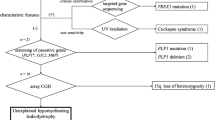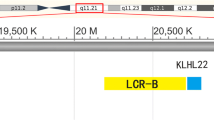Abstract
The proteolipid protein 1 (PLP1) gene is known to be mutated in the X-linked disorders of myelin formation Pelizaeus–Merzbacher disease (PMD) and spastic paraplegia type 2. The most commonly found PLP1 mutations are gene duplications (60–70%) and point mutations (20%). About 20% of patients with a PMD phenotype do not present identified PLP1 mutation, thus suggesting genetic heterogeneity and/or undetected PLP1 abnormalities. Except the recently described MLPA screening the seven exonic regions, the currently used techniques to quantify PLP1 gene copy number do not investigate small intragenic PLP1 rearrangements. Using the multiplex amplifiable probe hybridization (MAPH) technique, we looked simultaneously for intragenic rearrangements along the PLP1 gene (exonic and regulatory regions) and for rearrangements in the GPM6B candidate gene (a member of the proteolipid protein family). We tested 262 hypomyelinating patients: 56 PLP1 duplicated patients, 1 PLP1 triplicated patient, and 205 patients presenting a leukodystrophy of undetermined origin with brain MRI suggesting a defect in myelin formation. Our results show that MAPH is an alternative reliable technique for diagnosis of PLP1 gene copy number. It allows us (1) to demonstrate that all PLP1 duplications previously found encompass the whole gene, (2) to establish that copy number changes in GPM6B and intragenic duplications of PLP1 are very unlikely to be involved in the etiology of UHL, and (3) to identify one partial triplication and two partial deletions of PLP1 in patients presenting with a PMD phenotype.




Similar content being viewed by others
References
Inoue K, Osaka H, Sugiyama N, Kawanishi C, Onishi H, Nezu A, Kimura K, Yamada Y, Kosaka K (1996) A duplicated PLP gene causing Pelizaeus–Merzbacher disease detected by comparative multiplex PCR. Am J Hum Genet 59:32–39
Wang PJ, Hwu WL, Lee WT, Wang TR, Shen YZ (1997) Duplication of proteolipid protein gene: a possible major cause of Pelizaeus–Merzbacher disease. Pediatr Neurol 17:125–128
Sistermans EA, de Coo RF, De Wijs IJ, Van Oost BA (1998) Duplication of the proteolipid protein gene is the major cause of Pelizaeus–Merzbacher disease. Neurology 50:1749–1754
Mimault C, Giraud G, Courtois V, Cailloux F, Boire JY, Dastugue B, Boespflug-Tanguy O (1999) Proteolipoprotein gene analysis in 82 patients with sporadic Pelizaeus–Merzbacher disease: duplications, the major cause of the disease, originate more frequently in male germ cells, but point mutations do not. The Clinical European Network on Brain Dysmyelinating Disease. Am J Hum Genet 65:360–369
Cailloux F, Gauthier-Barichard F, Mimault C, Isabelle V, Courtois V, Giraud G, Dastugue B, Boespflug-Tanguy O (2000) Genotype–phenotype correlation in inherited brain myelination defects due to proteolipid protein gene mutations. Clinical European Network on Brain Dysmyelinating Disease. Eur J Hum Genet 8:837–845
Inoue K (2005) PLP1-related inherited dysmyelinating disorders: Pelizaeus–Merzbacher disease and spastic paraplegia type 2. Neurogenetics 6:1–16
Raskind WH, Williams CA, Hudson LD, Bird TD (1991) Complete deletion of the proteolipid protein gene (PLP) in a family with X-linked Pelizaeus–Merzbacher disease. Am J Hum Genet 49:1355–1360
Inoue K, Osaka H, Thurston VC, Clarke JT, Yoneyama A, Rosenbarker L, Bird TD, Hodes ME, Shaffer LG, Lupski JR (2002) Genomic rearrangements resulting in PLP1 deletion occur by nonhomologous end joining and cause different dysmyelinating phenotypes in males and females. Am J Hum Genet 71:838–853
Woodward K, Kendall E, Vetrie D, Malcolm S (1998) Pelizaeus–Merzbacher disease: identification of Xq22 proteolipid–protein duplications and characterization of breakpoints by interphase FISH. Am J Hum Genet 63:207–217
Schiffmann R, Boespflug-Tanguy O (2001) An update on the leukodsytrophies. Curr Opin Neurol 14:789–794
Inoue K, Osaka H, Imaizumi K, Nezu A, Takanashi J, Arii J, Murayama K, Ono J, Kikawa Y, Mito T, Shaffer LG, Lupski JR (1999) Proteolipid protein gene duplications causing Pelizaeus–Merzbacher disease: molecular mechanism and phenotypic manifestations. Ann Neurol 45:624–632
Regis S, Filocamo M, Mazzotti R, Cusano R, Corsolini F, Bonuccelli G, Stroppiano M, Gatti R (2001) Prenatal diagnosis of Pelizaeus–Merzbacher disease: detection of proteolipid protein gene duplication by quantitative fluorescent multiplex PCR. Prenat Diagn 21:668–671
Charbonnier F, Raux G, Wang Q, Drouot N, Cordier F, Limacher JM, Saurin JC, Puisieux A, Olschwang S, Frebourg T (2000) Detection of exon deletions and duplications of the mismatch repair genes in hereditary nonpolyposis colorectal cancer families using multiplex polymerase chain reaction of short fluorescent fragments. Cancer Res 60:2760–2763
White S, Kalf M, Liu Q, Villerius M, Engelsma D, Kriek M, Vollebregt E, Bakker B, van Ommen GJ, Breuning MH, den Dunnen JT (2002) Comprehensive detection of genomic duplications and deletions in the DMD gene, by use of multiplex amplifiable probe hybridization. Am J Hum Genet 71:365–374
Bombieri C, Bonizzato A, Castellani C, Assael BM, Pignatti PF (2005) Frequency of large CFTR gene rearrangements in Italian CF patients. Eur J Hum Genet 13:687–689
Uhlenberg B, Schuelke M, Ruschendorf F, Ruf N, Kaindl AM, Henneke M, Thiele H, Stoltenburg-Didinger G, Aksu F, Topaloglu H, Nurnberg P, Hubner C, Weschke B, Gartner J (2004) Mutations in the gene encoding gap junction protein alpha 12 (connexin 46.6) cause Pelizaeus–Merzbacher-like disease. Am J Hum Genet 75:251–260
Yan Y, Lagenaur C, Narayanan V (1993) Molecular cloning of M6: identification of a PLP/DM20 gene family. Neuron 11:423–431
Olinsky S, Loop BT, DeKosky A, Ripepi B, Weng W, Cummins J, Wenger SL, Yan Y, Lagenaur C, Narayanan V (1996) Chromosomal mapping of the human M6 genes. Genomics 33:532–536
Werner H, Dimou L, Klugmann M, Pfeiffer S, Nave KA (2001) Multiple splice isoforms of proteolipid M6B in neurons and oligodendrocytes. Mol Cell Neurosci 18:593–605
Dobretsova A, Wight PA (1999) Antisilencing: myelin proteolipid protein gene expression in oligodendrocytes is regulated via derepression. J Neurochem 72:2227–2237
Li S, Moore CL, Dobretsova A, Wight PA (2002) Myelin proteolipid protein (Plp) intron 1 DNA is required to temporally regulate Plp gene expression in the brain. J Neurochem 83:193–201
Armour JA, Sismani C, Patsalis PC, Cross G (2000) Measurement of locus copy number by hybridisation with amplifiable probes. Nucleic Acids Res 28:605–609
Vaurs-Barriere C, Bonnet-Dupeyron M-N, Combes P, Gauthier-Barichard F, Reveles XT, Schiffmann R, Bertini E, Rodriguez D, Vago P, Armour JAL, Saugier-Veber P, Frebourg T, Leach RJ, Boespflug-Tanguy O (2005) Golli-MBP copy number analysis by FISH, QMPSF and MAPH in 195 patients with hypomyelinating leukodystrophies. Ann Hum Genet (in press). DOI 10.1111/j.1529-8817.2005.00208.x
Akrami SM, Winter RM, Brook JD, Armour JA (2001) Detection of a large TBX5 deletion in a family with Holt-Oram syndrome. J Med Genet 38:E44
Sismani C, Armour JA, Flint J, Girgalli C, Regan R, Patsalis PC (2001) Screening for subtelomeric chromosome abnormalities in children with idiopathic mental retardation using multiprobe telomeric FISH and the new MAPH telomeric assay. Eur J Hum Genet 9:527–532
Akrami SM, Rowland JS, Taylor GR, Armour JA (2003) Diagnosis of gene dosage alterations at the PMP22 gene using MAPH. J Med Genet 40:e123
Kriek M, White SJ, Bouma MC, Dauwerse HG, Hansson KB, Nijhuis JV, Bakker B, van Ommen GJ, den Dunnen JT, Breuning MH (2004) Genomic imbalances in mental retardation. J Med Genet 41:249–255
Wolf NI, Sistermans EA, Cundall M, Hobson GM, Davis-Williams AP, Palmer R, Stubbs P, Davies S, Endziniene M, Wu Y, Chong WK, Malcolm S, Surtees R, Garbern JY, Woodward KJ (2005) Three or more copies of the proteolipid protein gene PLP1 cause severe Pelizaeus–Merzbacher disease. Brain 128:743–751
Bridge PJ, Clark C, Bleoo S, Graham LM, Fletcher D, Yunker LM, Innes A, Lowry R, Parboosingh JS, INHERIT BRCAs (2005) Technical and ethical considerations in the use of MLPA technology. Eur J Hum Genet 13S1:P0983
Henneke M, Wehner LE, Hennies HC, Preuss N, Gartner J (2004) Mutation analysis of the M6b gene in patients with Pelizaeus–Merzbacher-like syndrome. Am J Med Genet A 128:156–158
Hudson LD (2004) Proteolipid protein gene. In: Lazzarini RA (ed) Myelin biology and disorders, vol.1. Elsevier, London, pp 401–420
Kozak M (1999) Initiation of translation in prokaryotes and eukaryotes. Gene 234:187–208
Acknowledgements
We are grateful to the members of the clinical European Network on Brain Dysmyelinating Disease (ENBDD) and of LeukoFrance Network who have provided us with samples from their patients: M. Baethmann, T. Billette, B. Chabrol, D. Chaigne, J.M. Cuisset, I. Desguerre, J. Gartner, F. Hanefeld, A. Kohlschutter, P. Landrieu, J.M. Lopes-Terradas, M. Mayer, J.M. Prats-Vinas, D. Rating, R. Surtees, G. Uziel, L. Vallee, T. Voit with the collaboration of M.A. Barthez-Carpentier, A. Brady, P. Burkart, G. Cioni, B. Dan, G. Echenne, P. Evrard, B. Fontaine, C. Hübner, I. Krägeloh-Mann, J.P. Misson, J. Motte, A. Munich, J.M. Pedespan, B. Plecko, G. Ponsot, F. Rivier, G. Sebire, C. Steen, H. Steinbock, M. Troncoso, C. Vahule, R. Van Coster, L. Van Maldergen, C. Yalcinkaya. This study was supported by the European Leucodystrophy Association, the Foundation for Medical Research (ARS 2000), and the Jean-Pierre and Nancy Boespflug myopathic research foundation.
Author information
Authors and Affiliations
Corresponding author
Rights and permissions
About this article
Cite this article
Combes, P., Bonnet-Dupeyron, MN., Gauthier-Barichard, F. et al. PLP1 and GPM6B intragenic copy number analysis by MAPH in 262 patients with hypomyelinating leukodystrophies: identification of one partial triplication and two partial deletions of PLP1 . Neurogenetics 7, 31–37 (2006). https://doi.org/10.1007/s10048-005-0021-1
Received:
Accepted:
Published:
Issue Date:
DOI: https://doi.org/10.1007/s10048-005-0021-1




